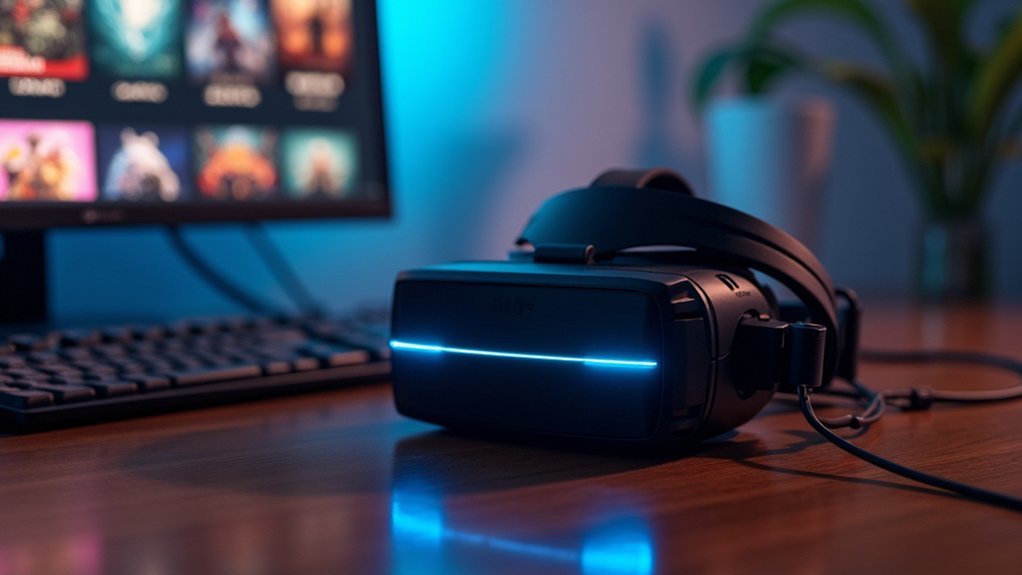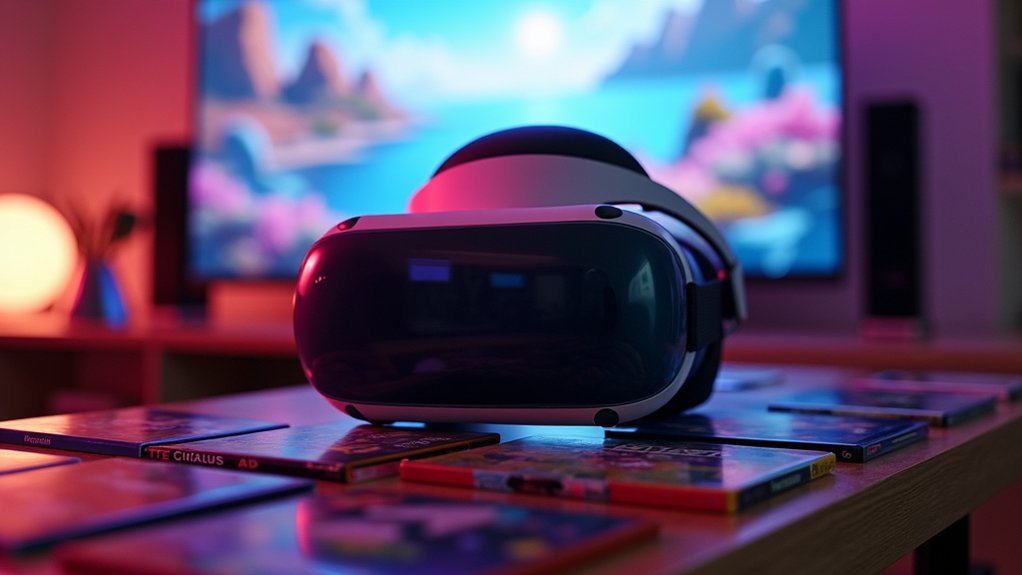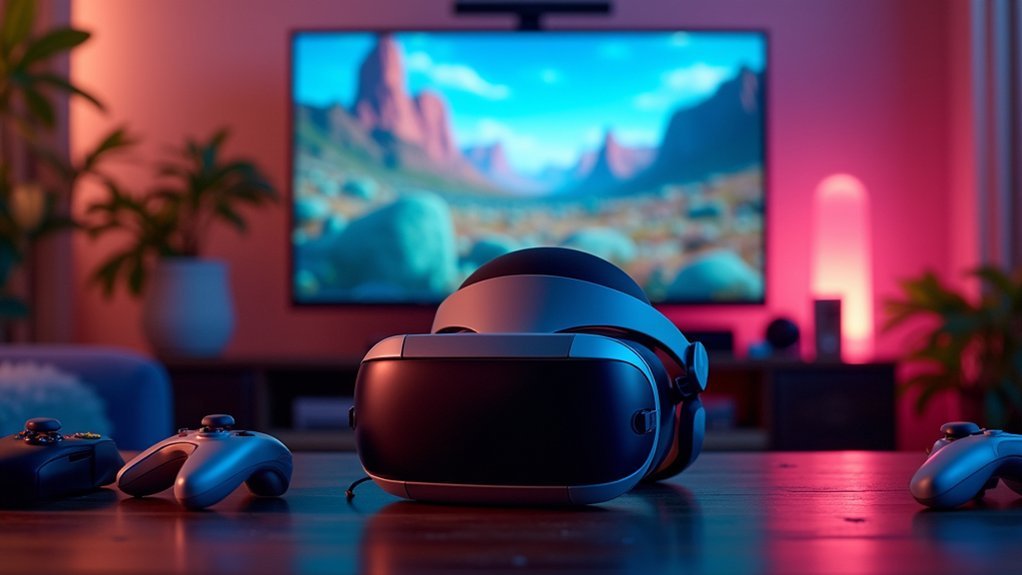You can gain access to SteamVR games across all headsets by installing Steam and SteamVR on your VR-ready PC, which supports Valve Index, HTC Vive, Oculus Rift, and Windows Mixed Reality devices. Connect your Meta Quest 3 using USB-C cable or Air Link for wireless play, and install ReVive to access Oculus exclusives on non-Oculus headsets. Keep firmware updated and guarantee proper Wi-Fi setup for wireless connections. Below you’ll discover the complete setup process and optimization techniques.
Understanding SteamVR Cross-Platform Compatibility

When you’re exploring the VR gaming landscape, SteamVR stands out as one of the most versatile platforms due to its impressive cross-platform compatibility.
You’ll find that SteamVR supports an extensive range of VR headsets, including the Valve Index, HTC Vive, Oculus Rift, and Windows Mixed Reality devices. This broad compatibility means you can access the same game library regardless of which headset you choose.
Most SteamVR titles work seamlessly across various VR systems, though you might encounter some older games with limited compatibility that primarily support Oculus headsets.
The platform’s cross-platform compatibility eliminates hardware restrictions, letting you focus on enjoying immersive experiences rather than worrying about whether your specific VR headset will work with your desired games.
Setting Up Your VR Headset for SteamVR Access
Before you can plunge into SteamVR’s extensive game library, you’ll need to properly configure your VR headset for Steam access. First, verify your VR headset’s compatibility and install Steam plus SteamVR on your VR-ready PC.
| Headset Type | Connection Method |
|---|---|
| Valve Index/HTC Vive | Direct USB/DisplayPort cable |
| Oculus Rift | USB 3.0 + HDMI/DisplayPort |
| Meta Quest 3 | High-quality USB-C or Air Link |
| Windows Mixed Reality | USB 3.0 + HDMI/DisplayPort |
For Meta Quest 3 users, you’ll connect via USB-C cable or wirelessly through Air Link using a strong 5 GHz Wi-Fi network. Set up your Chaperone boundaries to define your play area safely. Use the VR Status Monitor to customize performance settings and troubleshoot connections, ensuring you can play games smoothly.
Connecting Meta Quest 3 to Steam Gaming Library

Although the Meta Quest 3 operates as a standalone VR headset, you’ll access Steam’s vast gaming library by establishing a connection to your VR-ready PC.
First, install Steam, SteamVR applications, and the Meta PC App on your computer. You can connect using two methods: wired with a high-quality USB-C cable through Oculus Link, or wirelessly via Air Link when both devices share the same 5 GHz Wi-Fi network.
Once connected, activate Oculus Link or Air Link through your headset settings to gain access to your SteamVR library.
Keep your Meta Quest 3 charged during gameplay to prevent interruptions.
You’ll now explore diverse VR experiences, from “Half-Life: Alyx” to “Beat Saber,” dramatically expanding your virtual reality gaming options beyond the Quest store’s native titles.
Wireless Gaming With Oculus Quest Using ALVR
You can break free from cables and experience SteamVR games wirelessly on your Oculus Quest using ALVR, a free open-source solution that streams PC VR content directly to your headset.
Setting up ALVR requires enabling developer mode, configuring firewall settings, and installing the client app through SideQuest.
When connection issues arise, you’ll need specific troubleshooting techniques to maintain smooth wireless gameplay.
ALVR Setup Process
While setting up ALVR requires several technical steps, the process becomes straightforward once you follow the proper sequence.
First, download the latest ALVR server files from GitHub and verify you’ve installed current Visual C++ support on your PC. After extracting the files, run `add_firewall_rules.bat` as Administrator to configure necessary permissions.
Next, use SideQuest to install the ALVRClient APK on your Oculus Quest by selecting the file from your computer. Once installation completes, launch the ALVR server on your PC and grant firewall access when prompted.
Open the ALVR app on your Quest to establish connection with the server.
Finally, start SteamVR on your PC to begin playing your library wirelessly through your headset.
Wireless Connection Troubleshooting
Getting ALVR running doesn’t guarantee a flawless wireless gaming experience. You’ll need to troubleshoot connection issues when they arise.
First, verify both your Quest and PC connect to the same 5 GHz Wi-Fi network for peak performance. If you’re experiencing latency problems, check for interference from other devices and move closer to your router.
Keep your ALVR server software and ALVRClient APK updated to the latest versions for maximum compatibility.
Audio streaming problems often require virtual audio cables or additional software to facilitate proper sound transmission.
Regularly adjust your ALVR settings to match your network performance and headset capabilities.
Monitor bandwidth usage and consider dedicating your 5 GHz network exclusively to VR gaming for the best results.
ReVive: Playing Oculus Exclusives on Any Headset

One powerful tool breaks down the barriers between VR ecosystems: ReVive. This compatibility layer transforms Oculus-exclusive games into experiences you can enjoy on any VR headsets, including HTC Vive, Valve Index, and Windows Mixed Reality devices.
ReVive works by translating Oculus-specific calls into formats your headset understands. You’ll need the Oculus software installed on your PC, as ReVive relies on the Oculus API to launch games.
ReVive acts as a translator, converting Oculus-specific commands into language your non-Oculus headset can understand and execute.
Once configured, you’ll access popular titles like “Beat Saber” and “Lone Echo” that were previously locked to Oculus hardware.
The software receives regular updates, ensuring compatibility with new releases while improving performance and stability.
You’re no longer limited by your headset choice—ReVive expands your gaming library considerably.
Optimizing Performance Across Different VR Systems
You’ll need to guarantee your PC meets specific hardware compatibility standards to run VR games smoothly across different headset types.
Your system’s GPU, CPU, and RAM requirements vary depending on whether you’re using an Oculus, HTC Vive, or other VR headset.
Fine-tuning your system’s performance settings becomes essential when switching between different VR platforms to maintain consistent frame rates and reduce motion sickness.
Hardware Compatibility Standards
While SteamVR’s broad hardware compatibility spans multiple headset manufacturers, enhancing performance across different VR systems requires understanding each device’s unique specifications and capabilities.
You’ll need to meet specific hardware compatibility standards to guarantee seamless operation across various VR systems. SteamVR’s universal approach means you can switch between headsets while maintaining consistent performance levels.
Key requirements include:
- Graphics Card: High-end GPU with dedicated VR optimization features
- RAM: Minimum 8GB, though 16GB provides better stability
- CPU: Multi-core processor capable of handling real-time rendering
- USB Ports: Multiple USB 3.0+ connections for headset and controller tracking
You can customize SteamVR settings according to your specific hardware configuration, allowing you to balance visual fidelity with frame rate stability for superior VR experiences.
System Performance Tuning
Although SteamVR supports various headset manufacturers, achieving peak performance requires fine-tuning your system settings to match each device’s specific capabilities.
You’ll want to regularly update your headset firmware and SteamVR software to access the latest performance enhancements. Adjust SteamVR settings based on your PC’s hardware—lower resolution or modify supersampling to maintain smooth frame rates.
Use the VR Status Monitor to track system performance and identify bottlenecks that could compromise your VR experience.
Verify your PC meets or exceeds recommended specifications for GPU, CPU, and RAM requirements. For wireless setups, maintain a stable 5 GHz Wi-Fi network to reduce latency when using Air Link or similar streaming applications.
These optimizations guarantee top-notch performance regardless of your headset choice.
Hardware Requirements for Multi-Platform VR Gaming
Before diving into SteamVR’s vast library, you’ll need hardware that can handle the demanding requirements of multi-platform VR gaming.
Your VR-ready PC must deliver sufficient processing power and graphics capabilities to guarantee peak performance across different headsets.
Essential components for successful multi-platform VR gaming include:
- Software Foundation – Install Steam and SteamVR applications on your PC to access the extensive VR library.
- Connection Hardware – Secure a high-quality USB-C cable or establish a strong 5 GHz Wi-Fi connection for wireless setups.
- Headset-Specific Software – Download required apps like Meta PC App for Quest 3 connectivity.
- Regular Updates – Maintain current firmware and software versions for peak compatibility.
Meeting these headset requirements guarantees seamless gaming experiences regardless of your chosen VR platform.
Troubleshooting Common Compatibility Issues
Even with proper hardware setup, you’ll likely encounter compatibility issues when running SteamVR games across different headsets.
First, verify your headset appears on SteamVR’s official supported hardware list, as not every device works with all games. Install ReVive to access Oculus-exclusive titles on non-Oculus headsets, expanding your game library considerably.
Keep your headset firmware and SteamVR software updated regularly—these updates often fix compatibility bugs and improve game support.
When you experience performance problems, adjust SteamVR settings to match your PC’s capabilities. Lower resolution and graphics quality settings can remarkably improve gameplay smoothness.
For wireless setups, connect both your headset and PC to the same 5 GHz Wi-Fi network. This guarantees peak performance when using features like Air Link for wireless gaming.
Maximizing Your VR Game Library Potential
Once you’ve resolved compatibility issues, you can dramatically expand your VR gaming options by leveraging cross-platform tools and strategic library management.
Cross-platform compatibility transforms your VR experience from limited hardware restrictions into an expansive, unified gaming ecosystem with unlimited potential.
Here’s how to maximize your VR game library potential:
- Install ReVive – This application lets you play Oculus-exclusive titles on non-Oculus headsets, instantly expanding your available VR games beyond SteamVR’s native offerings.
- Utilize wireless connectivity – Connect your Meta Quest 3 or Quest 2 wirelessly to access SteamVR games without cable limitations, enhancing your gaming freedom.
- Leverage standalone capabilities – Use your Quest headset’s standalone functionality for quick gaming sessions, then connect to PC for enhanced SteamVR performance when desired.
- Stay updated – Regular SteamVR updates improve compatibility across all headsets, ensuring you’ll access new optimizations and game releases seamlessly.
Frequently Asked Questions
How Do I Get Steam Games on My VR Headset?
You’ll need a VR-ready PC with Steam and SteamVR installed. Connect your headset using USB-C cable or wireless options like Air Link. Enable developer mode for Quest headsets and optimize settings for smooth gameplay.
How Many VR Headsets Can You Have on Steam?
You can connect multiple VR headsets to your Steam account without a strict limit. However, you’ll only use one headset actively during gameplay, and you can switch between them seamlessly.
How Do I Force a Game to Open on Steamvr?
Launch SteamVR first, then start your game from Steam’s library. If it doesn’t work, right-click the game, select Properties, and add “-vr” to launch options to force VR mode.
Can You Transfer Steamvr Games to Oculus Quest 2?
You can’t directly transfer SteamVR games to Quest 2, but you’ll play them by connecting your headset to a VR-ready PC using Oculus Link or Air Link features.





Leave a Reply